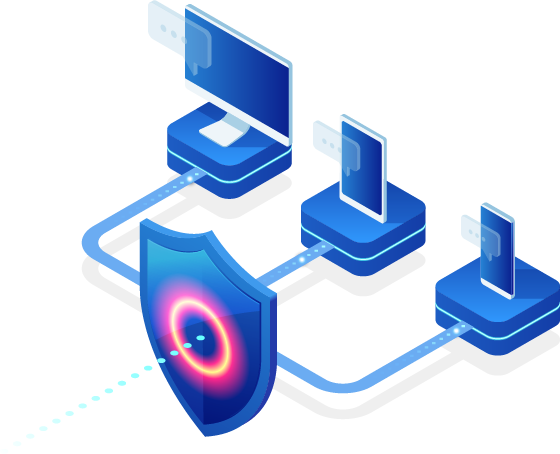Vulnerability Management
Our Vulnerability Management service helps organizations identify weaknesses in their IT network system. We provide the support your organization needs to proactively identify security vulnerabilities and address them before they are exploited. As part of a back-to-back Vulnerability Management & Assessment System, we will identify, evaluate, rectify and report on your security vulnerabilities and loopholes.
Vulnerability scanning is a crucial part of an organization’s security team’s general IT risk management method for a number of reasons. Data breaks often occur due to unpatched vulnerabilities, so finding and removing these security breaches eliminates that attack vector. No wonder, visionary cybersecurity companies hire services of ace information security consultants to thwart potential data breaches or ransomware attacks.
Keeping up with changes to your business’s network can be difficult. Business expansion and infrastructure changes imply that new flaws must be rapidly and regularly identified and addressed to ensure important data and assets are not left exposed. Therefore, security risk analysis and a robust security incident response are at the heart of farsighted security organizations that lay huge emphasis on data privacy.

AMSAT Managed Vulnerability Scanning service combines the latest vulnerability scanning devices and skilled security specialists to proactively review your network and provide the vision and direction required to address such security flaws and mitigate the risks for your organization.
Organizations of all sizes require regular vulnerability assessment to enable them to operate securely and efficiently. AMSAT’s seasoned professionals with its state-of-the-art Security Operations provide monitoring events on a 24/7 basis, helping organizations implement robust, consistent and stable cybersecurity practices.
Our Methodology
Vulnerability management software can help automate vulnerability assessment process. Our experts use vulnerability scanners to scan endpoint agents on a network and find vulnerabilities. The identified vulnerabilities are evaluated for the risk they pose in different contexts in order to make sound decisions of mitigating these threats.
Procedure of Vulnerability Management
- Identifying Vulnerabilities
- Evaluating Vulnerabilities
- Treating Vulnerabilities
- Reporting Vulnerabilities

Identifying Vulnerabilities
The main step of vulnerability management solution is identifying vulnerability through scanning. This is done by vulnerability scanning, which consists of four stages:
- Scan network-accessible systems by pinging them or sending them TCP/UDP packets
- Identify open ports and services running on scanned systems
- If possible, remotely log in to systems to gather detailed system information
- Correlate system information with known vulnerabilities
Our vulnerability scanners use a vulnerability database that contains list of publicly-known vulnerabilities. They are able to identify variety of systems running on a network, such as laptops and desktops, virtual and physical servers, databases, firewalls, switches, printers, etc. Identified systems are probed for different attributes: operating system, open ports, installed software, user accounts, file system structure, system configurations, and more.
Organizations of all sizes require regular vulnerability assessment to enable them to operate securely and efficiently. AMSAT’s seasoned professionals with its state-of-the-art Security Operations provide monitoring events on a 24×7 basis, helping organizations implement robust, consistent and stable cyber security practices.
EVALUATING VULNERABILITIES
After the identification of vulnerabilities, evaluation is needed so the risks posed by them are dealt with appropriately and in accordance with an organization’s risk management strategy. Vulnerability management solutions will provide different risk ratings and scores for vulnerabilities, such as Common Vulnerability Scoring System (CVSS) scores. Our services will evaluate the vulnerabilities on below mentioned factors:
- Is this vulnerability a true or false positive?
- Could someone directly exploit this vulnerability from the Internet?
- How difficult is it to exploit this vulnerability?
- Is there known, published exploit code for this vulnerability?
- What would be the impact to the business if this vulnerability were exploited?
- Are there any other security controls in place that reduce the likelihood and/or impact of this vulnerability being exploited?
- How old is the vulnerability/how long has it been on the network?
Treating Vulnerabilities
Once vulnerability has been validated and risk is calculated, next step is coordination with client on prioritizing the treatment of those vulnerabilities. There are different ways to treat vulnerabilities, including:
Remediation: Complete fixing or patching vulnerability so it can’t be exploited. This is the ideal treatment option that organizations strive for.
Mitigation: Lessening the likelihood and/or impact of a vulnerability being exploited. This is sometimes necessary when a proper fix or patch isn’t yet available for an identified vulnerability.
Acceptance: Taking no action to fix or otherwise lessen the likelihood/impact of a vulnerability being exploited. This is typically justified when vulnerability is on a low risk.
When treatment activities are completed, our team run another vulnerability scan to confirm that the vulnerability has been fully resolved.
Reporting vulnerabilities
Performing regular and continuous vulnerability assessments enable organizations to understand the efficiency of their vulnerability management program over time. The automated solutions typically have different options for exporting and visualizing vulnerability scan data with a variety of customizable reports and dashboards. This process helps IT teams understand the remediation techniques that will help them fix the most vulnerabilities with the least amount of effort, or help security teams monitor vulnerability trends over time in different parts of their network. The process also helps support organizations’ compliance and regulatory requirements.
Ready to Get Started?
Our specialists are ready to tailor our security service solutions to fit the needs of your organization.





